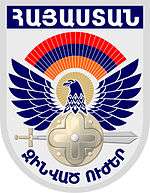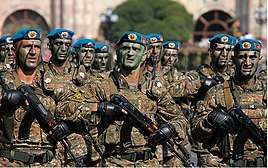Armenian Army
The Armenian Army (Armenian: Հայկական բանակ, Haykakan Banak) is the largest branch of the Armed Forces of Armenia and consists of the ground forces responsible for the country's land-based operations. It was established in conjunction with the other components of Armenia's military on January 28, 1992, several months after the republic declared its independence from the Soviet Union.[2] The army's first head was the former deputy commander-in-chief of the main staff of the Soviet Ground Forces, Norat Ter-Grigoryants.[3]
| Army of the Republic of Armenia | |
|---|---|
| Հայկական բանակ Haykakan Banak | |
 Emblem of the Armenian Army. | |
| Founded | 28 January 1992 |
| Country | |
| Type | Army |
| Role | Ground warfare |
| Size | 45,850 (including 19,950 professional and 25,900 conscripts)[1] (2013 census) |
| March | Our name is Armenian Army |
| Engagements | Nagorno-Karabakh War Peacekeeping roles in Kosovo, Afghanistan and Lebanon |
| Commanders | |
| Notable commanders |
|
Since the end of the Nagorno-Karabakh War, Armenia has committed many elements of the army to help bolster the defense and defend the unrecognized Republic of Artsakh from a possible renewal of hostilities with neighboring Azerbaijan. Jane's World Armies reports that both conscripts and officers from Armenia are routinely sent for duty to Artsakh, often posted to the frontline between Artsakh Armenian and Azerbaijani forces.[4]
History
The Armenian army's history is described to have gone through three stages of development.[5] It entered the first stage in February 1988, from the beginning of the Nagorno-Karabakh conflict, when Armenian militias were formed to combat Azerbaijani units in Artsakh. On 20 September 1990, the first military unit was created, the Yerevan Special Regiment, with the first oath being held in the Republican Assembly Point and was attended by the first President of Armenia Levon Ter-Petrosyan, Prime Minister Vazgen Manukyan, Vazgen Sargsyan.[6] The second phase of the development of the army began in 1992, several months after Armenia declared its independence from the Soviet Union. Ter-Grigoryants and civilian officials in the Armenian Ministry of Defense, including Vazgen Manukyan and Vazgen Sargsyan, sought to establish a "small, well-balanced, combat-ready defense force."[7] The third phase began after the end of the war and continues to today.
Most of the army's staff officers were members of the former Soviet military. An estimated 5,000 Armenians were serving as high-level officers in the military at the time of the collapse of the Soviet Union.[8] Almost immediately after its independence, Armenia was embroiled in the Nagorno-Karabakh War with neighboring Azerbaijan. Intending to establish a force of 30,000 men, the army's standing force increased to 50,000 by early 1994. During the war, the military remained on high alert and bolstered defenses in the region of Zangezur, opposite the Azerbaijani exclave of Nakhichevan. Purported artillery bombardment in May 1992 from the region led to skirmishes between the two sides, including the Armenian army's incursion into several villages into Nakhichevaan.
Since 1994, the army has taken an active role in ensuring the defense of the Republic of Artsakh in conjunction with the Artsakh Defense Army.[9]
International deployments

The Armenian army has collaborated in several international missions with the West. On February 12, 2004, Armenia deployed a platoon-sized unit (three squads) to Kosovo as a part of the Greek peacekeeping battalion. The unit, known as the Peacekeeping Forces of Armenia, is headquartered in Camp "REGAS FEREOS" as a part of the Multi-National Task Force East and is tasked with maintaining vehicle check points, providing security for the base but also serves as a quick reaction force and crowd and riot control.[10] In 2008, the KFOR unit was expanded, adding a second platoon plus company staff (bringing Armenia's contingent to about 85 personnel).[11]
In the autumn of 2004, the Armenian government approved the dispatch of a 46-man contingent from the army consisting of sappers, engineers and doctors under Polish command as part of the Multi-National Force – Iraq. On November 10, 2006, Senior Lieutenant Georgy Nalbandyan was injured in a mine explosion in Iraq but survived after being transported for surgery to a hospital in Landstuhl, Germany, near Ramstein Air Base.[12] On October 6, 2008, due to improving security conditions, the contingent's tour of duty came to an end.[13]
In July 2009, the Defense Minister of Armenia, Seyran Ohanyan, announced that Armenia would send a force to participate with the International Security Assistance Force (ISAF) in the War in Afghanistan by the end of the year. He did not mention how large the force would be but did note that it probably would include munitions experts and communications officers. A MOD spokesmen also stated that the force would include medical specialists and translators as well. Ohanyan added that Armenian officers who served in the Soviet military during the Soviet–Afghan War also expressed the desire to return there as members of the new force.[14] In November 2009, a NATO official affirmed that an Armenian contingent numbering 30 troops will join the ISAF sometime in early 2010.[15] That number was revised to 40 in early December, when the Armenian parliament overwhelmingly voted in approval of the contingent's deployment. The servicemen arrived in Afghanistan in February 2010, where, under German command, they are tasked to defend the regional airport in Kunduz.[16] There are currently 126 servicemen in Afghanistan.[17]
In conjunction with its strategic allies, Armenia has sent over 1,500 officers to be trained in Greece and Russia.[5] The Armenian Ministry of Defense also established in 2004 a joint partnership with the Kansas National Guard in order to exchange knowledge and facilitate cooperation in national security and civilian affairs. It also signed a military cooperation plan with Lebanon on November 27, 2015.[18]
Organization

Field Forces

- 1st Army Corps (HQ Goris):[4] one independent tank battalion, one independent reconnaissance battalion, two motor rifle regiments.[19]
- 2nd Army Corps (HQ Khachaghbyur): one independent tank battalion, one independent reconnaissance battalion, one independent rifle regiment, two independent motor rifle regiments, one independent artillery battalion.
- 3rd Army Corps (HQ Vanadzor): one independent rifle regiment, one independent artillery battalion, one independent tank battalion, one independent reconnaissance battalion, one independent rocket artillery battalion, four independent motor rifle regiments, one maintenance battalion, one signals battalion.
- 4th Army Corps (HQ Yeghegnadzor): four independent motor rifle regiments, an independent self-propelled artillery battalion, one signals battalion.
- 5th Army Corps (HQ Nubarashen in Yerevan): two fortified regions, one independent motor rifle regiment, one independent rifle regiment.
Army-level Troops
The army also has the following army level units:[19][20]
- One air and air defence joint command (Jane's World Armies mentions an Army Air and Air Defence at Chobankara)
- One training motor rifle brigade
- One special forces regiment (Jane's World Armies mentions a regiment at Nubarashen)
- One artillery brigade
- One self-propelled artillery regiment
- One anti-tank regiment
- One engineer regiment with demining centre
- One surface-to-air missile brigade
- Two surface-to-air missile regiments
- One radiotechnical (radar) regiment
Chaplaincy Program
The Army Chaplaincy Program of the Armenian Church is made up of more than 50 clergymen serve as military chaplains to the Armed Forces of Armenia. They organize various religious programs in the military, including delivering lectures and prayers [21] It is jointly funded and sponsored by the Ministry of Defence of Armenia and the Armenian Orthodox Church (the national church of Armenia). All army chaplains are commissioned officers in the armed forces who hold a military rank. It was established in 1997 on the basis of a joint initiative of Catholicos Karekin I and Defense minister Vazgen Sargsyan. Since 2011, combined clergy company has taken part in the quinquennial Armenian Independence Day Parade on Republic Square in Yerevan.
Special Forces

The Armenian military's special forces include a standard army special forces regiment (now grown into a brigade)[22], and 3+ reconnaissance battalions. (Excluding Nagorno-Karabakh Defense Army Special Forces and National Defense forces, both of which are heavily integrated into the Armenian Armed Forces.) The operational history surrounding all the aforementioned groups are not known, the operation's that are known and are outside of standard duties such as intelligence gathering include:
- Unknown number of cross-border raids [23]
- The securing of Armenian pilot's remains and helicopter parts after the shoot down of a Nagorno-Karabakh helicopter[24]
The special forces of both republics are allowed fast-attack vehicles to conduct some operations and exercises. Special Forces Day is celebrated on 5 November.[25]
Equipment
March
Our name is Armenian Army (Armenian: Մեր անունն է հայկական բանակ, romanized: tr, lit. 'Mer anunn e haykakan banakak') is an Armenian military march that serves as the army anthem. The song is part of the traditional repertoire of the Band of the General Staff of the Armed Forces. The march is composed of the following verses:[26]
The new stone is placed on the old stone. |
See also
- Armenian Air Defense
- Armenian Air Force
- Military history of Armenia
Notes
- International Institute for Strategic Studies (IISS). The Military Balance 2013. London: Routledge, 2013, pp. 215–16.
- "Military Balance in Europe 2011"., March 07, 2011.
- Petrosyan, David. "Formation and Development of Armenian Armed Forces." Moscow Defence Brief. Centre for Analysis of Strategies and Technologies, Moscow, 6-2002, accessed November 2009. Ter-Grigoryants had previously served with the 40th Army (Soviet Union) in Afghanistan as chief of staff, supervising operations in May 1982.
- Jane's World Armies. Coulsdon, Surrey, UK: Jane's Information Group, October 2004.
- Ministry of Defense of Armenia. General History of the Armenian Army Archived 2007-09-27 at the Wayback Machine. Retrieved January 31, 2006.
- LLC, Ayb Solutions. "LEGEND OF THE SPECIAL REGIMENT". Hay Zinvor. Retrieved 2020-05-15.
- Curtis, Glenn E. and Ronald G. Suny. "Armenia," in Armenia, Azerbaijan, and Georgia Country Studies, ed. Glenn E. Curtis. Washington D.C.: Federal Research Division Library of Congress, 1995, p. 72.
- Mirsky, Georgiy I. On Ruins of Empire: Ethnicity and Nationalism in the Former Soviet Union. Westport, CT: Greenwood Press, 1997, p. 63. ISBN 0-313-30044-5.
- See Richard Giragosian, "Armenia and Karabakh: One Nation, Two States Archived 2010-12-09 at the Wayback Machine." AGBU Magazine. № 1, Vol. 19, May 2009, pp. 12-13.
- Kosovo Force. KFOR Contingent: Armenia. KFOR. Last updated January 24, 2006. Accessed February 9, 2007.
- NATO’s relations with Armenia. NATO. Retrieved November 29, 2009.
- "Armenian peacekeeper to undergo two more surgeries Archived 2007-09-27 at the Wayback Machine." Public Radio of Armenia. November 20, 2006. Retrieved February 1, 2007.
- Glassey, Eric. "Armenians Complete Successful Mission." Multinational Force in Iraq. October 7, 2008. Accessed September 6, 2009.
- "Armenia to send forces to Afghanistan this year Archived 2009-08-01 at the Wayback Machine." Armenian Reporter. July 24, 2009. Retrieved September 6, 2009.
- "Armenia To Send Troops To Afghanistan." RFE/RL. November 09, 2009. Retrieved November 29, 2009.
- "Armenian Parliament Endorses Troop Deployment To Afghanistan." RFE/RL. December 8, 2009. Retrieved January 3, 2010.
- International Institute for Strategic Studies (IISS). The Military Balance 2012. London: Routledge, 2012, pp. 90–91.
- "Armenia and Lebanon Sign 2016 Military Cooperation Plan." Massis Post. November 27, 2015.
- IISS (2007). The Military Balance 2007. London: Routledge for the IISS. p. 155. ISBN 978-1-85743-437-8.
- See Human Rights Watch/Helsinki Watch, Azerbaijan: Seven years of conflict in Nagorno-Karabakh, New York: Human Rights Watch, 1994, p. 69.
- The Army Chaplaincy Program of the Armenian Church
- The Military Balance, 2017. P. 198
- "Reconnaissance Scouts on Karabakh Frontline Tight-Lipped About Themselves, Their Actions". Hetq.am. Retrieved 24 December 2014.
- "Bodies of Armenian pilots removed from helicopter crash site". Reuters. 2014-11-22. Retrieved 24 December 2014.
- http://www.mil.am/en/news/4475
- https://www.impoqrik.am/hayreniq/3263-%D5%84%D5%A5%D6%80-%D5%A1%D5%B6%D5%B8%D6%82%D5%B6%D5%B6-%D5%A7-%D5%B0%D5%A1%D5%B5%D5%AF%D5%A1%D5%AF%D5%A1%D5%B6-%D5%A2%D5%A1%D5%B6%D5%A1%D5%AF-%D5%BD%D5%B8%D5%BE%D5%B8%D6%80%D5%A5%D5%B6%D6%84-%D5%A5%D6%80%D5%A3%D5%A5%D5%AC.html
